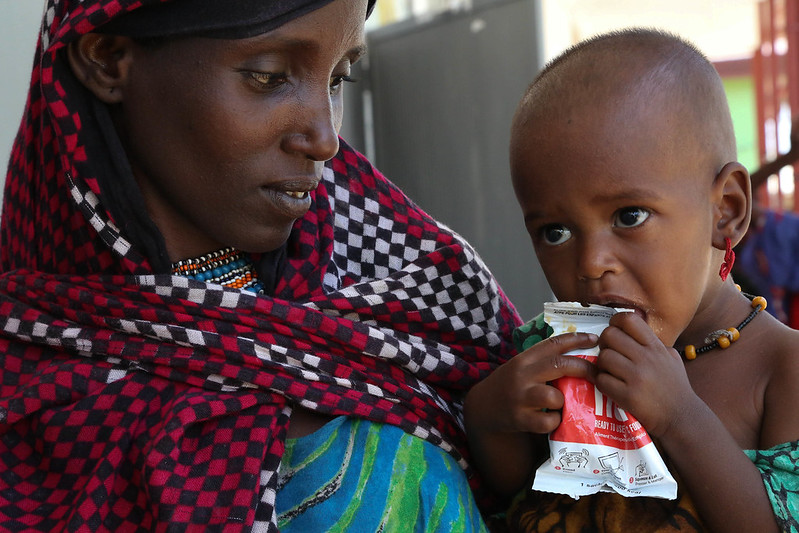The Fight to End Malnutrition in Ethiopia
 Malnutrition has been a significant problem in Ethiopia, starting with the 1983 hunger shortage that left many without food and nutritional value. Then in the early 2020s, Ethiopia suffered from a severe drought which caused almost 6.8 million livestock to pass away. As a country that heavily depends on agriculture, drought has caused an increase in food insecurity and malnutrition, according to Disaster Philanthropy. Crop production also fell due to pests that roamed the farms, leading to a downfall in maize production from 25 million tons to more than four million tons. However, three organizations have currently been on the road to improving malnutrition in Ethiopia.
Malnutrition has been a significant problem in Ethiopia, starting with the 1983 hunger shortage that left many without food and nutritional value. Then in the early 2020s, Ethiopia suffered from a severe drought which caused almost 6.8 million livestock to pass away. As a country that heavily depends on agriculture, drought has caused an increase in food insecurity and malnutrition, according to Disaster Philanthropy. Crop production also fell due to pests that roamed the farms, leading to a downfall in maize production from 25 million tons to more than four million tons. However, three organizations have currently been on the road to improving malnutrition in Ethiopia.
United Nations International Children’s Emergency Fund
The United Nations International Children’s Emergency Fund (UNICEF) has primarily been working with the government to resolve this issue. It supports the government’s nutrition program called the Health Extention Program which was developed in 2004. The main focus of this program is to increase awareness about nutrition actions in households, limit bacteria with vaccinations and promote healthy behaviors. In addition, it allows for family health services, putting the spotlight on helping adolescent nutrition.
UNICEF also works with the pilot program that allows for a new innovative way of growing crops, which has been especially beneficial in preventing damage from sudden hits by natural disasters. Through this new method in hydroponic vegetable farming, malnutrition rates have gone down, especially for children. This practice allows farmers to grow food with little soil and water, perfect for situations of extreme drought. Not only did self-sufficiency increase through this process, allowing farmers to cultivate year-round, but it also has made farming practices sustainable, as this process promises generations of this usage.
United States Agency for International Development
The United States Agency for International Development (USAID) has accomplished many tasks involving increasing nutrition access. Feed the Future movement which aims to end world hunger is one of its most influential successes. This organization not only aims to increase the amount of agricultural produce, but it also seeks to increase wages earned through their produce to increase their income and buy products to lift them out of poverty.
In Ethiopia specifically, there are three main steps that USAID and Feed the Future have been following to aid poverty. The three steps are as follows:
- Supporting sustainable agricultural growth with an increase in market accessibility, providing further job opportunities and creating a range of crops and cattle to make use of.
- Increasing the flexibility in agriculture by modernizing their system’s ability to adapt to new conditions, especially with natural disasters and also bettering the organization of different resources.
- Improving nutrition, particularly for the more vulnerable demographics like women and children, by implementing new ways to address and target specific malnutrition problems like providing financial literacy.
Results for Development
Results for Development (R4D) is a global nonprofit that works with government officials and social leaders to create grand changes in health and nutrition. R4D has aimed to integrate wasting treatment into the health care routine of Ethiopia, especially when wasting has become one of the largest mortality causes for small children.
By incorporating ready-to-use therapeutic food (RUTF), R4D has begun to address the severe underweight problem caused by malnutrition. But even though this product is made with high quality and is cost-effective, it is not widely available to minorities. This issue is currently on the road to becoming resolved through market shaping which would introduce more access to RUTFs. Ethiopia is one of the countries that has access to this solution through R4D. This organization is looking to increase funding for RUTF to increase its presence in markets and create a set of cost-effective recipes.
Looking Forward
Malnutrition is a heavily prevalent issue in Ethiopia, with more than 5 million children in Ethiopia suffering. However, through actions provided by these three organizations, UNICEF, USAID and R4D, malnutrition is on its way to being tackled in this country.
– Linda Yoonseo Lee
Linda is based in Phoenix, AZ, USA and focuses on Good News for The Borgen Project.
Photo: Flickr
